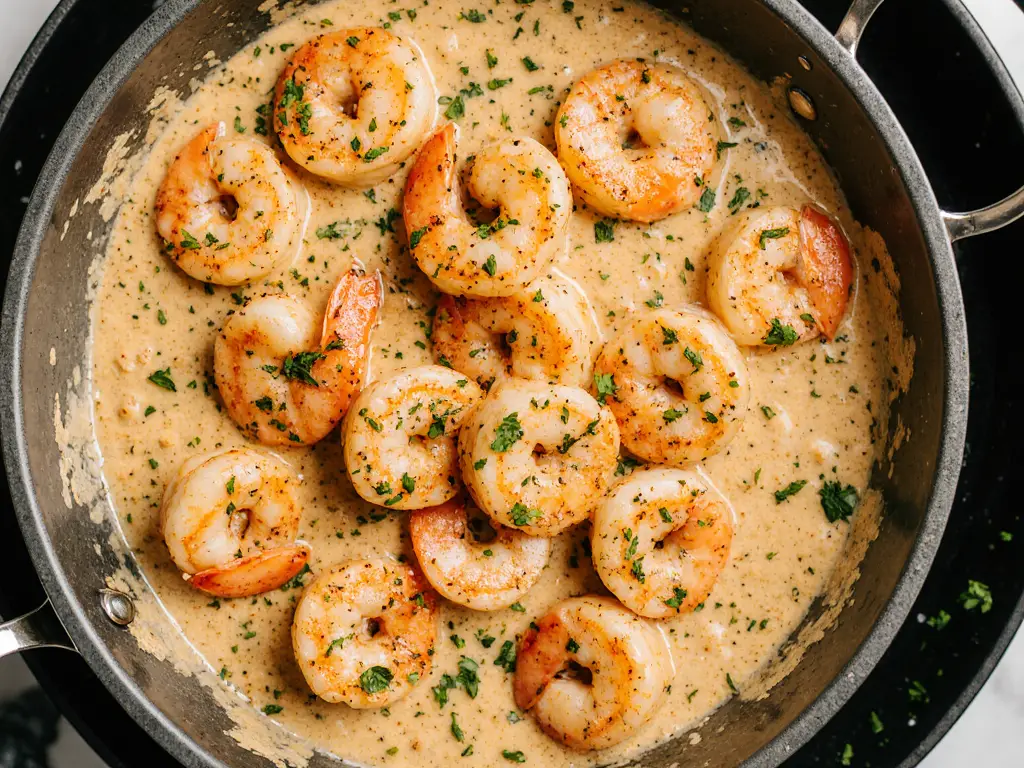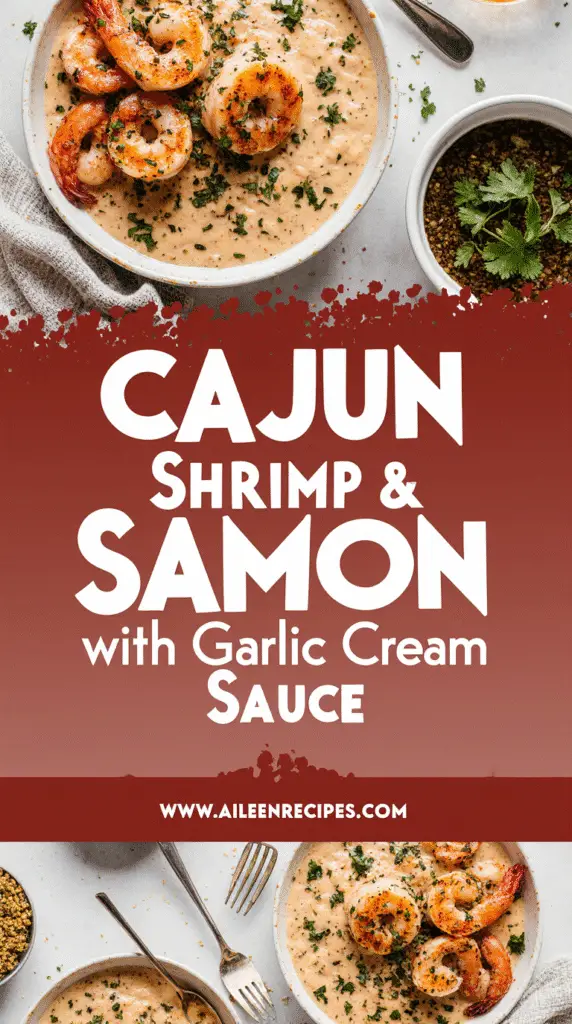How to Make Restaurant-Quality Cajun Salmon and Shrimp Recipe (With Garlic Cream Sauce)
Did you know our cajun salmon and shrimp recipe takes just 20 minutes to prepare from start to finish?
That’s right – this restaurant-quality seafood dish can be on your table in about 30 minutes or less, making it perfect for both weeknight dinners and special occasions. The combination of 4-ounce salmon filets and one pound of jumbo shrimp creates an impressive meal that’s surprisingly simple to execute.
Furthermore, this dish is a one-pan wonder, but be prepared – the sauce is so good you’ll want to scoop up every last drop! Whether you’re cooking with wild-caught seafood or using thawed frozen shrimp, the results are consistently delicious.
In this article, we’ll walk you through creating this perfect cajun salmon with cream sauce step by step. From properly cooking salmon to an internal temperature of 145°F to preparing the garlic cajun cream sauce that brings everything together, we’ve got you covered. We’ll also share our best tips for cajun shrimp and salmon pasta variations and how to plate your creation like a professional chef.
Ready to impress your family or guests with minimal effort? Let’s dive into this mouthwatering cajun salmon and shrimp pasta recipe!
Essential Ingredients and Substitutions
The foundation of any exceptional cajun salmon and shrimp recipe lies in selecting quality ingredients. The right combination creates that perfect balance of flavors that makes this dish truly memorable.
Choosing the right salmon and shrimp
For salmon, aim for the head end of the fish rather than the tail portion, as it’s fattier and more succulent. Wild-caught salmon offers superior flavor, though farm-raised works well when wild isn’t available. Each person typically needs a 4-5 ounce portion for a satisfying meal.
When selecting shrimp, size matters depending on your presentation goals. Jumbo shrimp create an impressive visual impact, while smaller shrimp work well for more economical preparations. Notably, peeling and deveining before cooking ensures the best eating experience—and don’t forget to remove the tails for easier consumption.
Homemade vs. store-bought Cajun seasoning
Making your own Cajun seasoning gives you complete control over both salt and spice levels—a significant advantage since many store-bought versions tend to be overly salty. A basic homemade blend includes paprika, garlic powder, onion powder, cayenne pepper, oregano, thyme, salt, and black pepper.
If you prefer store-bought options, consider brands like Slap Ya Mama for intense flavor, Habanero Cajun Seasoning from Hell for extreme heat, or Cajun Island Blackening Spice for traditional purist flavors.
Best cheeses for cream sauce
Parmesan cheese provides essential saltiness and nuttiness to your cajun cream sauce. Always choose freshly grated over pre-grated options, as the latter doesn’t melt properly. Additionally, Monterey Jack offers a mild flavor that melts beautifully, while some recipes successfully incorporate mozzarella for extra creaminess.
For those wanting substitutes, consider Romano or Asiago as Parmesan alternatives. Vegan options include nutritional yeast for that nutty flavor without dairy.
Optional add-ins like spinach or bell peppers
Fresh baby spinach not only adds vibrant color but also nutritional value to your cajun sauce. Red, orange, or green bell peppers introduce sweet crunch and visual appeal. Moreover, asparagus pieces can add texture contrast, while minced shallots or red onions create depth of flavor.
These flexible additions allow you to customize your cajun salmon and shrimp pasta recipe to your preferences without compromising the dish’s essential character.
Step-by-Step Cooking Instructions
The secret to creating a restaurant-worthy cajun salmon and shrimp dish lies in mastering a few key techniques. Let’s dive into the essential cooking methods that will elevate your seafood experience.
How to pan-sear salmon without drying it out
Starting with properly prepared salmon is crucial. Pat the filets completely dry with paper towels to remove excess moisture, which ensures a beautiful crispy exterior. Season generously with cajun spice and garlic powder.
Heat your skillet over medium-high heat until it’s properly hot—water droplets should sizzle on contact. Add oil and place the salmon skin-side down, pressing gently with a spatula for 10-15 seconds to prevent the skin from curling.
Let the salmon cook undisturbed for 3-4 minutes before flipping. This patience creates that coveted golden crust. After flipping, cook for another 3-4 minutes until it reaches an internal temperature of 145°F. The salmon should flake easily but remain moist inside.
Cooking shrimp to the perfect texture
For juicy rather than rubbery shrimp, timing is everything. Season with cajun spice and cook in a hot skillet for approximately 1-2 minutes per side, depending on size. Jumbo shrimp may require slightly longer cooking times.
Watch for visual cues of doneness—shrimp will turn from gray and translucent to pink and opaque. Properly cooked shrimp curl into a C-shape; if they curl into tight circles, they’re overcooked. Remove them immediately when just done to prevent toughening.
Making the garlic Cajun cream sauce
In the same pan used for seafood, add butter and sauté minced garlic until fragrant but not browned—about 30 seconds. Initially add sundried tomatoes or bell peppers if using, cooking until softened.
Pour in chicken broth, bringing to a simmer while scraping the pan bottom to incorporate those flavorful bits. Reduce heat to low before adding heavy cream to prevent splitting. Let simmer 3-5 minutes until slightly thickened.
Finish with freshly grated Parmesan cheese and a squeeze of lemon juice, which brightens the rich sauce. For extra heat, add hot sauce to taste.
Combining seafood and sauce for final plating
Arrange the seared salmon on plates first, then place the cooked shrimp on top. Subsequently drizzle the cajun cream sauce generously over both. This layering method ensures each component maintains its texture while being enhanced by the sauce.
For restaurant-style presentation, consider adding height by stacking components. Additionally, a sprinkling of fresh herbs such as parsley adds vibrant color contrast against the creamy sauce and salmon.
Serving and Pairing Ideas
A perfectly cooked cajun salmon and shrimp dish deserves exceptional accompaniments to create a complete dining experience. Let me show you how to transform this seafood masterpiece into a memorable meal through thoughtful pairings and presentation.
Best sides for Cajun salmon and shrimp
The ideal sides for cajun salmon and shrimp should complement rather than compete with these flavorful proteins. Creamy mashed potatoes or parsnip puree create an excellent base that soaks up the rich cajun cream sauce. For lighter options, consider:
- Roasted vegetables like asparagus, zucchini, or broccoli for balance
- A bright, refreshing salad such as cucumber, tomato-avocado, or wedge salad
- Crusty bread for mopping up every bit of that irresistible sauce
Especially for those seeking low-carb alternatives, roasted vegetables alone make a nutritious pairing. Indeed, the spicy cajun flavors pair wonderfully with dry white wines like Pinot Grigio or Sauvignon Blanc.
How to serve with pasta or rice
Pasta transforms this dish into a hearty, restaurant-style meal. Penne or fettuccine works beautifully by capturing the creamy sauce in their ridges and hollows. Alternatively, linguine or spaghetti excel at being thoroughly coated with sauce.
For rice preparations, jasmine or basmati varieties create a hearty foundation. Consequently, during plating, arrange the rice or pasta first, followed by the seafood, finally drizzling the creamy cajun sauce over everything.
Garnishing for restaurant-style presentation
To achieve that professional look, finish your cajun salmon and shrimp with finely chopped fresh parsley. Lemon wedges not only add visual appeal but provide a refreshing acid balance. Primarily, arrange the seafood attractively on a serving platter or individual plates, drizzling sauce artfully over top rather than drowning the dish. Additional Parmesan cheese sprinkled as a final touch adds both flavor and visual texture.
Storage, Reheating, and Make-Ahead Tips
Properly handling leftover cajun salmon and shrimp ensures you can enjoy this delicious meal beyond the initial serving. Here’s how to make the most of your culinary creation.
How to store leftovers properly
Always cool your cajun salmon and shrimp completely before refrigerating, yet don’t leave it at room temperature for more than 2 hours. Store in airtight containers to prevent the seafood from absorbing other odors in your refrigerator. Consume refrigerated seafood within 3-4 days, though for optimal quality, I recommend using it within 2-3 days.
Reheating without drying out the seafood
Gentle reheating is crucial for seafood. Avoid microwaves whenever possible. Instead, preheat your oven to 275°F, place the seafood on a foil-lined baking dish, cover with foil, and heat for approximately 15 minutes. Alternatively, reheat in a skillet over low heat with a splash of liquid to maintain moisture. Regardless of method, aim for an internal temperature of 165°F.
Making the sauce ahead of time
The cajun cream sauce can be prepared 2-3 days ahead and stored in an airtight container. Upon reheating, warm it gently over low heat, stirring frequently to prevent separation. Add a splash of cream, milk, or broth if the sauce thickens too much. Unlike seafood, creamy cajun sauces don’t freeze well due to separation upon thawing.
Conclusion
Mastering this cajun salmon and shrimp recipe will certainly transform your home cooking experience. This impressive dish takes merely 20 minutes to prepare yet delivers restaurant-quality results that will amaze family and guests alike. The combination of perfectly pan-seared salmon, tender shrimp, and that irresistible garlic cajun cream sauce creates a meal worthy of special occasions but simple enough for weeknight dinners.
Throughout this guide, we’ve covered everything from selecting quality ingredients to achieving the perfect seafood textures. Therefore, you now have all the knowledge needed to prepare seafood that’s crispy on the outside while remaining moist and flavorful inside. The versatility of this recipe also stands out – you can serve it with pasta, rice, or low-carb options depending on your dietary preferences.
Additionally, the make-ahead options allow for convenient meal planning without sacrificing flavor. Although seafood typically doesn’t store well for long periods, proper storage techniques ensure you can enjoy leftovers for a few days after preparation. The cajun cream sauce, meanwhile, can be prepared days in advance, making dinner assembly even quicker when needed.
After all, cooking should bring joy rather than stress. This one-pan wonder delivers exactly that – minimum cleanup with maximum flavor impact. We encourage you to experiment with the suggested variations like adding spinach or bell peppers to customize the dish to your taste preferences.
Most importantly, remember that confidence is key when cooking seafood. Follow our temperature guidelines and visual cues for doneness, and you’ll achieve perfect results every time. This cajun salmon and shrimp recipe will undoubtedly become a favorite in your cooking repertoire, bringing restaurant-worthy dining right to your kitchen table.
FAQs
Q1. How long does it take to prepare this Cajun salmon and shrimp dish? This delicious meal can be prepared in about 20-30 minutes, making it perfect for both weeknight dinners and special occasions.
Q2. What’s the best way to cook salmon without drying it out? Pan-sear the salmon skin-side down in a hot skillet for 3-4 minutes, then flip and cook for another 3-4 minutes until it reaches an internal temperature of 145°F. This method ensures a crispy exterior while keeping the inside moist.
Q3. Can I make my own Cajun seasoning for this recipe? Absolutely! A homemade Cajun blend typically includes paprika, garlic powder, onion powder, cayenne pepper, oregano, thyme, salt, and black pepper. Making your own allows you to control the salt and spice levels.
Q4. What are some good side dishes to serve with Cajun salmon and shrimp? Great options include creamy mashed potatoes, roasted vegetables like asparagus or broccoli, a refreshing salad, or crusty bread to soak up the sauce. For a heartier meal, you can also serve it over pasta or rice.
Q5. How should I store and reheat leftovers? Store leftovers in airtight containers in the refrigerator for up to 3-4 days. When reheating, avoid the microwave. Instead, gently warm in a 275°F oven, covered with foil, or in a skillet over low heat with a splash of liquid to maintain moisture.


